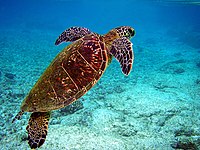
Photo from wikipedia
Methyl iodide (CH3I) released from ocean is an important carrier of iodine, which plays an important role in ozone depletion in the atmosphere. Depletion of ozone has increased the amount… Click to show full abstract
Methyl iodide (CH3I) released from ocean is an important carrier of iodine, which plays an important role in ozone depletion in the atmosphere. Depletion of ozone has increased the amount of ultraviolet radiation that reaches the earth's surface and recent global warming has caused oceanic acidification as well as dust events, but how these environmental changes will affect CH3I concentration in the ocean is unclear. In this study, the spatial distributions and sources of CH3I in the atmosphere, seawater, and sediment porewater were measured in the Yellow Sea (YS) and the East China Sea (ECS) between June and July 2018. Higher concentrations in the atmosphere, seawater, and sediment were found in the YS than in the ECS, and surface seawater emissions were discovered to be the major contributors of atmospheric CH3I concentrations. Anthropogenic pollutants could explain significant spatial variation in the distribution of CH3I. High concentrations of CH3I in sediment porewater increased diffusion into bottom waters, with diffusive fluxes of 0.2-6.5 nmol m-2 d-1. Preliminary results during the in situ seawater incubation experiments showed that the photochemical production rate of CH3I ranged from 0.008 to 0.214 pmol L-1 h-1 under ultraviolet light, and an enhancement emission of CH3I from phytoplankton occurred with the addition of dust, while a reduction of CH3I appeared under lower pH conditions.
Journal Title: Environmental pollution
Year Published: 2021
Link to full text (if available)
Share on Social Media: Sign Up to like & get
recommendations!